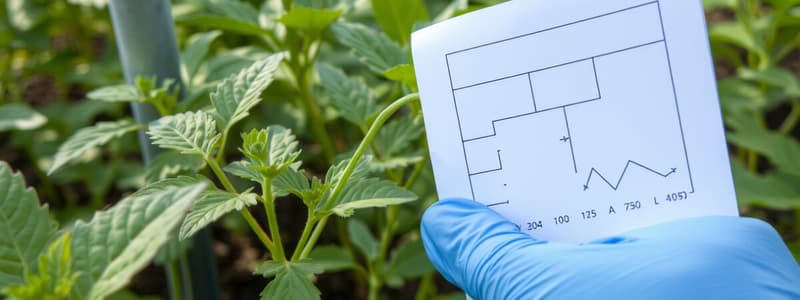Podcast
Questions and Answers
What are the primary objectives of plant protection in agriculture?
What are the primary objectives of plant protection in agriculture?
- Control pest populations and enhance pest resistance
- Increase the use of chemical pesticides
- Regulate international trade of agricultural products
- Augment crop production and improve quality of produce (correct)
What is a quarantine pest?
What is a quarantine pest?
- Any insect or organism that damages plant products
- A pest that is widely distributed and uncontrolled
- A pest that is easily eradicated with chemical treatments
- A pest of potential economic importance that is present but not widespread (correct)
Which of the following is a glaring example of international spread of a pest?
Which of the following is a glaring example of international spread of a pest?
- Powdery mildew from France to the USA
- Rust in coffee from USA to Mexico
- Blight in chestnut from Europe to Asia
- Boll weevil from Mexico to the USA (correct)
What does plant quarantine legislation aim to prevent?
What does plant quarantine legislation aim to prevent?
Which statement accurately describes PEST risk analysis?
Which statement accurately describes PEST risk analysis?
According to International Standards for Phytosanitary Measures (ISPM), what is a key component of pest management?
According to International Standards for Phytosanitary Measures (ISPM), what is a key component of pest management?
What is the goal of plant quarantine in the context of alleviating poverty and hunger?
What is the goal of plant quarantine in the context of alleviating poverty and hunger?
Which of these pathogens is NOT included in the definition of a pest?
Which of these pathogens is NOT included in the definition of a pest?
What is the first stage of Pest Risk Analysis (PRA)?
What is the first stage of Pest Risk Analysis (PRA)?
Which ISPM provides guidelines for pest risk analysis for quarantine pests?
Which ISPM provides guidelines for pest risk analysis for quarantine pests?
What is a quarantine pest?
What is a quarantine pest?
In Stage II of the PRA, which aspect is NOT assessed?
In Stage II of the PRA, which aspect is NOT assessed?
Which ISPM guideline focuses on the established areas of low pest prevalence?
Which ISPM guideline focuses on the established areas of low pest prevalence?
Which stage of the PRA involves monitoring and the application of phytosanitary measures?
Which stage of the PRA involves monitoring and the application of phytosanitary measures?
What is the purpose of the economic impact assessment in pest risk analysis?
What is the purpose of the economic impact assessment in pest risk analysis?
Which ISPM guideline guides the use of integrated measures in pest risk management?
Which ISPM guideline guides the use of integrated measures in pest risk management?
In which step of the PRA is information gathering essential?
In which step of the PRA is information gathering essential?
What is a requirement for a pest to be classified as regulated non-quarantine?
What is a requirement for a pest to be classified as regulated non-quarantine?
What is the first step in the Pest Risk Analysis (PRA) process?
What is the first step in the Pest Risk Analysis (PRA) process?
Which of the following is NOT a component of the risk assessment stage in the PRA process?
Which of the following is NOT a component of the risk assessment stage in the PRA process?
In the administrative process of import PRA, what is the purpose of stakeholder consultation?
In the administrative process of import PRA, what is the purpose of stakeholder consultation?
Which step in the PRA process involves independent evaluation by external experts?
Which step in the PRA process involves independent evaluation by external experts?
What role does capacity building play in establishing a PRA Unit?
What role does capacity building play in establishing a PRA Unit?
What is the primary goal of pest database development within the context of PRA?
What is the primary goal of pest database development within the context of PRA?
Which stage is responsible for final policy determination in the PRA process?
Which stage is responsible for final policy determination in the PRA process?
What is the primary focus of the enhanced role of plant protection?
What is the primary focus of the enhanced role of plant protection?
Flashcards are hidden until you start studying
Study Notes
Plant Protection in Agriculture
- Aims to augment crop production and improve the quality of produce.
- Legislation seeks to regulate trade activities through quarantine measures to reduce poverty, hunger, and malnutrition.
Plant Quarantine
- Legislative measure for regulating the movement of planting materials, products, soil, and living organisms.
- Prevents the inadvertent introduction and establishment of exotic pests which could threaten local agriculture.
Definition of Pests
- A pest is any species, strain, or biotype injurious to plants or plant products, including insects, nematodes, fungi, bacteria, and viruses.
- Quarantine pests are economically important species that are present but not widely distributed and are under official control.
Examples of International Pest Spread
- Late blight (potato) spread from Central America to Europe.
- Powdery mildew (grape) from the USA to France.
- Boll weevil (cotton) migration from Mexico to the USA.
Pathways for Pests
- Various ISPM guidelines inform pest risk management and phytosanitary measures, detailing certification, inspection, and non-compliance notifications.
WTO - SPS Regime
- Article 3 encourages review and harmonization of phytosanitary norms.
- Article 5 emphasizes developing Pest Risk Analysis (PRA) standards to determine pest-free areas and manage pest risk effectively.
Pest Risk Analysis (PRA)
- PRA begins with risk assessment and documentation leading to effective pest management strategies.
- Should be technically robust, justifiable, and achievable in practice.
Initiation of PRA
- Involves commodity-based and pest-based analysis to assess risk.
- Includes stages for information gathering and risk communication.
Stage I - Initiation of PRA
- Identifies potential pests based on area specificity and considers the implications of the organism being a pest.
- Reviews relevant policies and gathers necessary data.
Stage II - Pest Risk Assessment
- Categorizes pests by assessing the probability of introduction and economic impact to determine risks.
- Engages in a thorough analysis to weigh acceptable versus unacceptable risks.
Stage III - Pest Risk Management
- Involves monitoring and applying sanitary measures necessary for pest management, leading to regulatory decisions beyond the PRA process.
ISPMs Related to PRA
- ISPM No. 2 outlines various stages of PRA.
- Specific guidelines under ISPM No. 11 and No. 21 detail pest risk assessments for quarantine and non-quarantine pests respectively.
Case Study: Import of Canola Seed from Canada to Pakistan
- Involves a market access request, establishment of a PRA unit, and capacity building initiatives.
- Requires adherence to legislative and regulatory standards for import.
Administrative Process for Import PRA
- Involves initial proposal submission, scheduling, scoping, risk assessment, stakeholder consultations, peer review, and determination of pest management measures.
- Finalizes the PRA process through notifications, reporting, and appeals.
Enhanced Role of Plant Protection
- Focus not only on increasing quantity and quality of agricultural produce but also on facilitating and promoting trade through effective pest risk analysis and management strategies.
Studying That Suits You
Use AI to generate personalized quizzes and flashcards to suit your learning preferences.




